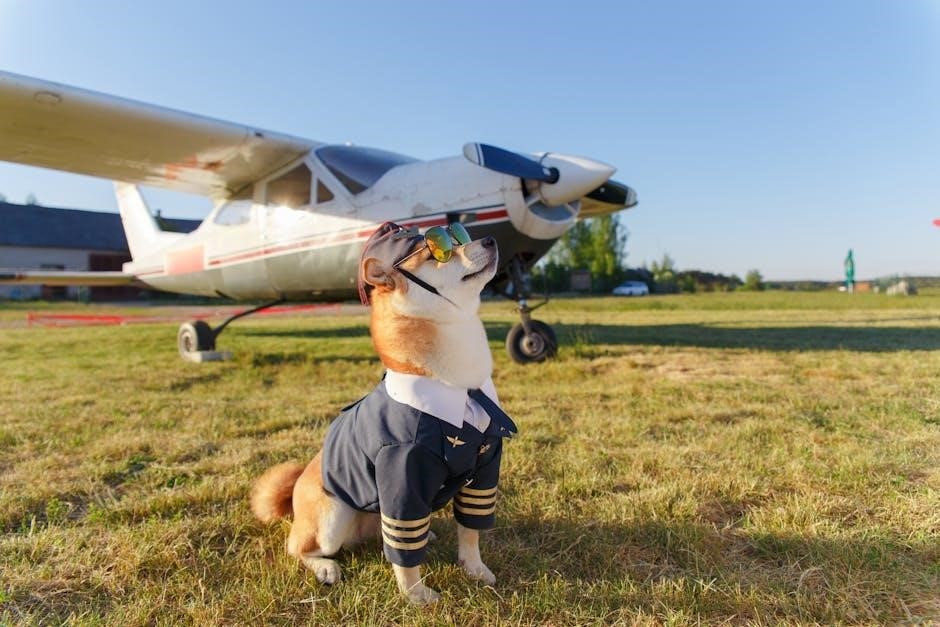
flight suit size guide
This guide provides essential insights into selecting the right flight suit size, ensuring comfort, mobility, and safety for pilots and aviation professionals. Proper fit is crucial for optimal performance during flights.
Understanding the Importance of Proper Fit
A proper-fitting flight suit is critical for both comfort and performance. It ensures unrestricted mobility, which is essential for pilots and aviation professionals who require full range of motion. A well-fitted suit also enhances safety by preventing distractions caused by discomfort or restricted movement. If the suit is too tight, it can cause irritation and impede circulation, while a suit that is too loose may bunch up, potentially interfering with equipment. Proper fit also ensures the suit’s flame-resistant properties function as intended. Measuring accurately and considering factors like layering and fabric stretch helps achieve the ideal fit. A flight suit that fits correctly not only boosts confidence but also allows for optimal functionality in high-stress environments.
Overview of Flight Suit Types and Their Sizing Needs
Flight suits vary in design and material, each catering to specific needs. Nomex flight suits, commonly used by military pilots, prioritize flame resistance and durability, with sizing based on chest, waist, and inseam measurements. The CWU-27/P model, for instance, offers a tailored fit with adjustable features. Two-piece suits provide flexibility, while one-piece suits offer simplicity but less adjustability. Custom suits allow for precise measurements, ensuring a perfect fit. Sizing needs differ by manufacturer, with some offering extended sizes. Fabric type and stretch also influence fit, as Nomex suits may have less give compared to other materials. Understanding these differences helps in selecting the right suit for individual requirements, ensuring both comfort and functionality in diverse aviation environments. Proper sizing is essential for safety and performance, making it crucial to follow specific measurement guidelines for each type.
How to Measure for a Flight Suit
Measure chest, waist, inseam, and sleeve length over the clothing you’ll wear underneath. Accurate measurements ensure a comfortable, functional fit for optimal performance and mobility.
Chest Measurement: Key to Determining Size

The chest measurement is the most critical factor in determining your flight suit size. To measure accurately, place the tape measure around the fullest part of your chest, keeping it level and parallel to the floor. Ensure the tape is snug but not tight, and take note of the measurement in inches or centimeters. This measurement will directly correspond to the size chart provided by manufacturers. For instance, a 34-inch chest typically falls into a specific size category, such as Small or Medium, depending on the brand. Always measure over the clothing you intend to wear underneath, as this will affect the fit. If your measurement falls between sizes, it is generally recommended to size up for comfort and mobility. Remember, a proper fit ensures both safety and performance during flights.
Waist Measurement: Ensuring Comfort and Mobility
The waist measurement is vital for ensuring your flight suit fits comfortably and allows for maximum mobility. To measure your waist accurately, wrap the tape measure around the narrowest point of your natural waistline, keeping it level and parallel to the floor. The measurement should be snug but not restrictive, as a tight waistband can limit movement and cause discomfort during long flights or physical activity. If your waist size does not align with your chest measurement, you may need to consider a different size or style. Always measure over the undergarments and layers you plan to wear beneath the suit, as this will affect the fit. If you are between sizes, sizing up is often recommended to ensure ease of movement and comfort.
Inseam Measurement: Avoiding Discomfort in the Groin Area
The inseam measurement is critical to prevent discomfort in the groin area, especially in one-piece flight suits where the fit cannot be adjusted. To measure your inseam accurately, stand upright and measure the distance from the base of your crotch to the bottom of your ankle. This ensures the suit’s leg length is appropriate, avoiding both excessive fabric bunching and a too-short fit that rides up uncomfortably. If your inseam does not match the standard size chart, consider a custom or tailored option. Always measure over the undergarments and layers you plan to wear, as this can add bulk and affect the inseam fit. Proper inseam length ensures freedom of movement and prevents chafing or restriction during extended periods of wear.
Sleeve Length: Importance of Proper Fit
Sleeve length is a vital measurement for a comfortable and functional flight suit. It should allow full arm mobility while maintaining coverage. Measure from the center back of the neck, over the shoulder, to the wrist with arms relaxed. Proper fit prevents sleeves from being too long, which can interfere with equipment, or too short, restricting movement. Ensure measurements are taken over undergarments and layers, as these can add bulk. Accurate sleeve length ensures the suit stays in place, allowing easy access to pockets and gear. A well-fitted sleeve enhances comfort during long missions, reducing fatigue and improving focus; Always refer to the manufacturer’s size chart for precise guidance, as sleeve length varies by design and intended use.
Flight Suit Size Charts
Flight suit size charts vary by manufacturer, offering standardized measurements for chest, waist, inseam, and sleeve length. They guide users to find their optimal fit, ensuring comfort and functionality;
Standard Size Charts for Nomex Flight Suits
Standard size charts for Nomex flight suits provide a structured approach to determining the correct fit. These charts typically include measurements for chest, waist, inseam, and sleeve length, ensuring accuracy. Nomex suits, known for their flame-resistance and durability, require precise sizing to maintain comfort and functionality. The charts often categorize sizes from XXS to XXL, with specific numerical ranges for each measurement. For instance, a chest measurement of 30-32 inches might correspond to a Small size, while inseam measurements ensure the suit’s length doesn’t cause discomfort. Users are advised to measure over undergarments and consider fabric stretch. Proper fit is essential for both safety and performance, making these charts a valuable tool for pilots and aviation professionals. By following the guidelines, individuals can select a suit that meets their needs effectively;
Understanding the CWU-27/P Flight Suit Size Chart

The CWU-27/P flight suit size chart is a standardized guide for selecting the correct fit, primarily used by military personnel. It categorizes sizes based on chest, height, and sleeve measurements, ensuring a precise fit for various body types. For example, size 32XS corresponds to a chest of 31-32 inches, a height of 59-63 inches, and a sleeve length of 20 5/8 inches. The chart includes options like Short, Regular, and Long to accommodate different body proportions; Proper fit is crucial, as a one-piece suit cannot be adjusted. If measurements fall between sizes, sizing up is recommended to avoid discomfort. The chart also emphasizes the importance of inseam length to prevent the suit from riding up. By following the CWU-27/P size chart, users can ensure optimal comfort and functionality in their flight suits.
Comparing Manufacturer-Specific Size Charts
Manufacturer-specific size charts vary, making it essential to compare them when selecting a flight suit. For instance, Metasco and Propper offer detailed charts differing in measurements and fits. Metasco’s chart includes chest, waist, hip, sleeve, and inseam measurements, while Propper emphasizes height and sleeve length variations. Some manufacturers, like Gibson & Barnes, provide extended sizes without additional costs. Others, such as Rothco, include centimeter-based measurements for international customers. Additionally, anti-gravity suits have unique size charts focusing on height and weight. Custom options are available for precise fits. Always refer to the specific manufacturer’s guidelines, as sizing can differ significantly. This ensures the best fit for individual needs and preferences, enhancing comfort and performance during flights. Proper comparison prevents sizing errors and guarantees optimal functionality.

How to Choose the Right Size

Selecting the correct flight suit size involves measuring chest, waist, inseam, and sleeve length, then comparing to manufacturer charts. Consider fabric stretch and layering needs for optimal fit and comfort during flights. Proper sizing ensures mobility and avoids discomfort, enhancing performance and safety. Always measure over undergarments and check for size variations between brands to make an informed decision. Accurate measurements and understanding size charts are key to choosing the best fit for your needs. This ensures both comfort and functionality, critical for pilots and aviation professionals. A well-fitting suit enhances performance, safety, and overall satisfaction. Always refer to specific manufacturer guidelines for precise sizing. This guide helps you navigate the process effectively, ensuring the perfect fit every time. By following these steps, you can confidently select a flight suit that meets your requirements and preferences.
Considering Fabric Type and Stretch
Fabric type and stretch significantly impact flight suit sizing. Nomex, a common material, offers flame resistance and minimal stretch, requiring precise measurements for a snug fit. Stretch fabrics, like those with spandex, provide flexibility and may allow for a slightly smaller size. Always measure over undergarments, as layering affects fit. If choosing stretch fabric, consider whether you prefer a tighter or looser fit. Manufacturers often include stretch in specific areas, like sleeves or waist, to enhance mobility. Understanding fabric properties ensures optimal comfort and performance. For Nomex suits, sizing charts typically account for non-stretch material, so measure carefully to avoid a too-tight fit. Fabric type and stretch should guide your size selection to balance comfort and functionality. Proper consideration ensures the suit moves with you, reducing restrictions during flight. This attention to detail enhances overall performance and safety. Always consult manufacturer guidelines for fabric-specific sizing advice to make an informed decision.
Accounting for Undergarments and Layering
Undergarments and layering play a crucial role in achieving the perfect flight suit fit. Measure over the clothing you plan to wear underneath, as this affects chest, waist, and inseam measurements. For instance, bulky thermals or compression gear can add inches, necessitating a larger size. Conversely, minimal undergarments may allow for a smaller size. Layering systems, such as moisture-wicking base layers or flame-resistant mid-layers, should be considered to ensure the flight suit accommodates the added bulk without restricting movement. Always refer to manufacturer guidelines, as some suits are designed with specific layering in mind. Properly accounting for undergarments and layering ensures a comfortable, functional fit, preventing discomfort or mobility issues during flight. This step is essential for optimizing both performance and safety in the cockpit. Accurate measurement over intended undergarments guarantees the best possible fit.
When to Size Up or Down: Key Considerations
Deciding whether to size up or down depends on several factors, including personal comfort, intended use, and specific measurements. If your measurements fall between sizes, consider your activity level and the suit’s fabric type. For active flight duties, sizing up may provide better mobility, while a snug fit is preferable for minimal bulk. Layering requirements also influence this decision. If you plan to wear thick undergarments, sizing up ensures comfort and range of motion. Conversely, if you prefer a sleek fit without layers, sizing down might be appropriate. Always prioritize comfort and functionality, as an ill-fitting suit can compromise performance and safety. Refer to manufacturer guidelines, as some suits offer adjustable features or stretch fabrics that accommodate varying needs. Ultimately, the goal is to balance fit, comfort, and practicality for optimal performance. Proper sizing ensures both safety and efficiency during operations, making it a critical decision.
Specialized Flight Suit Sizing
Specialized sizing focuses on unique features like Nomex materials, two-piece vs. one-piece designs, and custom fits, ensuring precise measurements for comfort and safety in high-stress environments.
Nomex Flight Suit Sizing: Unique Features
Nomex flight suits are designed for durability and fire resistance, with sizing charts tailored to ensure a snug yet comfortable fit. The material’s thermal stability and lightweight construction make accurate measurements crucial. Key features include chest, waist, inseam, and sleeve length measurements, often requiring sizing up if between sizes. The fabric’s minimal stretch means precise fit is essential for mobility and safety. Manufacturers provide detailed charts, but personal measurements over undergarments are recommended. Unique to Nomex suits, the fit must accommodate the non-stretch fabric, ensuring comfort without compromise on protection. Proper sizing ensures optimal performance in high-stress environments, making Nomex suits a top choice for pilots.
Two-Piece vs. One-Piece Flight Suits: Sizing Differences
Two-piece and one-piece flight suits have distinct sizing requirements due to their design differences. Two-piece suits, consisting of a jacket and trousers, allow for greater flexibility in sizing adjustments. They often have separate size charts for tops and bottoms, enabling a more tailored fit. In contrast, one-piece suits require precise measurements, as they cannot be adjusted once worn. The inseam length is particularly critical for one-piece suits to prevent discomfort in the groin area. Manufacturers typically recommend sizing up if between sizes for one-piece suits, while two-piece suits offer more versatility. Understanding these differences is key to selecting the right style for comfort and functionality.
Custom Flight Suit Sizing: Options and Measurements
Custom flight suits offer tailored fits for unique body types or specific needs. Measurements are taken for chest, waist, inseam, and sleeve length to ensure accuracy. Some manufacturers provide options for adjustable features like waistbands or cuffs. Custom suits often require additional lead time and may cost more. They are ideal for those who find standard sizes inadequate. Proper fit is essential for comfort and performance, making custom suits a worthwhile investment for professionals requiring precise sizing. Always refer to the manufacturer’s guidelines for accurate measurements and ordering processes.

Troubleshooting Common Fit Issues
Addressing fit issues ensures comfort and functionality. Common problems include tightness, incorrect inseam length, and sleeve fit. Adjustments or reordering may be necessary for optimal performance.

What to Do If the Fit is Too Tight
If your flight suit feels too tight, assess the measurements. Tightness can restrict movement and comfort. Consider sizing up for a better fit or consulting the size chart again. Adjustments may involve reordering or seeking custom options. Proper fit ensures safety and performance during flights.
Adjusting for a Longer or Shorter Inseam
Accurate inseam measurement is vital for comfort. If the inseam is too short, it can cause discomfort, while a longer inseam may affect mobility. Measure from the crotch to the bottom of the foot. For one-piece suits, no adjustments are possible, so ensure correct sizing. If between sizes, size up for longer inseams or down for shorter ones. Proper fit prevents discomfort and ensures functionality during flights.
Resolving Discrepancies in Size Charts
Discrepancies in size charts can lead to poor fit, so comparing measurements across brands is essential. Manufacturers may vary in sizing, so always refer to specific charts. If unsure, contact customer support for guidance. Consider custom sizing options for a precise fit. Proper fit ensures both comfort and functionality, making it crucial to resolve size discrepancies before purchase. Use provided charts as a guide and verify measurements to avoid returns or alterations. Prioritize accurate fit for optimal performance and comfort during flights.
Choosing the right flight suit size ensures comfort, safety, and performance. By following size charts and measuring accurately, you’ll find the perfect fit for your needs. Proper fit enhances functionality and durability, making it vital for aviation professionals. Always consider fabric type, layering, and manufacturer specifics to make an informed decision. Remember, a well-fitting flight suit is an investment in both safety and comfort, ensuring peak performance during flights.
Final Tips for Ensuring the Best Fit
When selecting a flight suit, always measure over the clothing you plan to wear underneath, as this ensures accurate sizing. If you’re between sizes, opt for the larger option to avoid discomfort. Consider the fabric type, as materials like Nomex may have minimal stretch, requiring a precise fit. Double-check the inseam, sleeve length, and chest measurements to ensure mobility and comfort. If possible, try the suit on before purchasing or refer to manufacturer-specific size charts for the best results. Lastly, don’t hesitate to consult customer service or sizing guides if you’re unsure, as a proper fit is essential for both performance and safety.

Resources for Further Assistance

For additional guidance, refer to manufacturer websites like Metasco or Propper, which offer detailed sizing charts and measurement guides. Watch instructional videos on YouTube for visual step-by-step instructions. Visit specialized aviation stores or consult with industry experts for personalized advice. Online forums and communities, such as those dedicated to military or pilot gear, often provide real user experiences and tips. Lastly, many retailers provide customer support hotlines to address specific sizing concerns. Utilizing these resources ensures you make an informed decision and achieve the best fit for your flight suit.